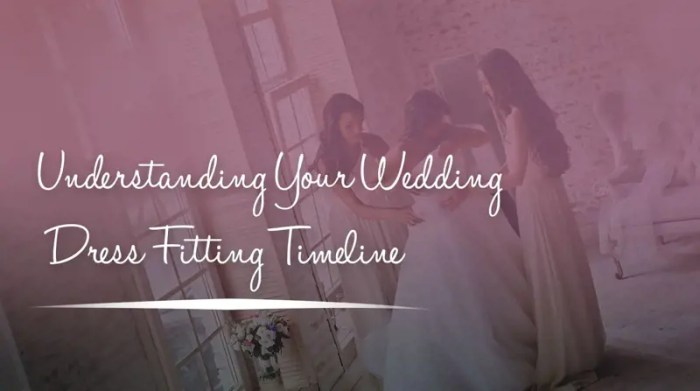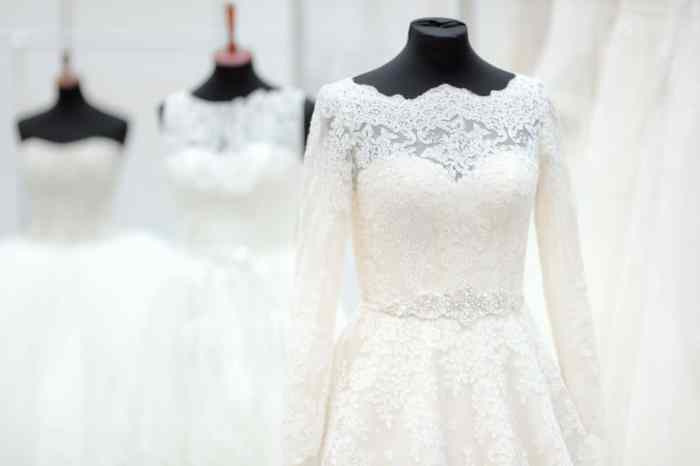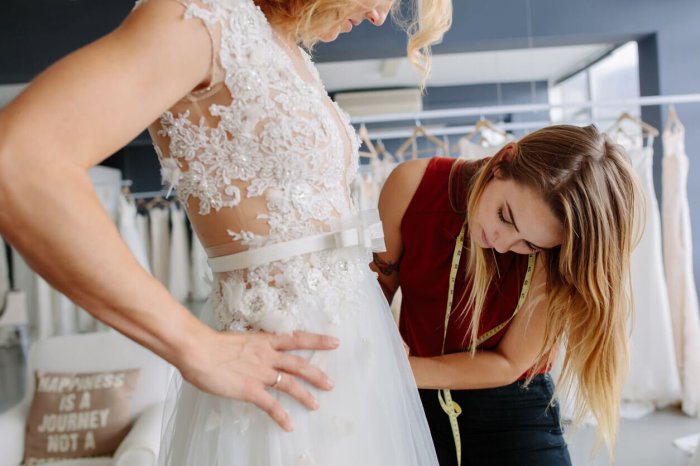Ideal Timeline for Wedding Dress Alterations: When To Get Wedding Dress Altered
When to get wedding dress altered – Planning your wedding dress alterations requires careful timing to ensure your dress is perfectly fitted and ready for your big day. A well-structured timeline, considering potential delays, is crucial for a stress-free experience. This section Artikels an ideal timeline, factors that might affect it, and strategies for managing the process effectively.
Ideal Alteration Timeline
The following table illustrates a typical timeframe for wedding dress alterations, broken down by stage. Remember that this is a guideline, and the actual timeline may vary based on several factors discussed later.
| Stage | Task | Typical Timeframe | Notes |
|---|---|---|---|
| Initial Consultation & First Fitting | Measurements, initial assessment of alterations needed, discussion of design preferences. | 1-2 weeks after dress purchase | Book this appointment well in advance, especially during peak wedding seasons. |
| Adjustments & Second Fitting | Seamstress makes initial alterations based on the first fitting. Additional measurements may be taken. | 4-6 weeks after the first fitting | This allows ample time for significant adjustments. |
| Final Fitting & Adjustments | Final checks for fit, minor adjustments, and final touches. Hemming, bustle adjustments, and any other last-minute details are addressed. | 2-3 weeks before the wedding | This fitting ensures everything is perfect before the wedding. |
Visual Representation of Ideal Timeline: Imagine a timeline with three key milestones: Initial Fitting (8-10 weeks before the wedding), Second Fitting (4-6 weeks before the wedding), and Final Fitting (2-3 weeks before the wedding). Each milestone is represented by a marker, with connecting lines illustrating the time between each stage. Potential delays, such as unexpected issues with the dress or seamstress availability, are represented by dashed lines extending the timeline.
This visual emphasizes the importance of early planning and proactive communication.
Factors Influencing Alteration Timeline
Several factors can influence the overall timeline for wedding dress alterations. Understanding these factors allows for better planning and realistic expectations.
- Dress Complexity: Intricate beading, layers of fabric, or unique design elements require more time for alterations.
- Seamstress Availability: Popular seamstresses often have limited availability, requiring earlier booking and potentially longer wait times between fittings.
- Extent of Alterations: Major alterations, such as significant resizing or restructuring, will naturally take longer than minor adjustments.
- Unexpected Issues: Unforeseen problems, such as fabric damage or fitting challenges, can add unexpected delays.
Factors Affecting Alteration Timing
The ideal time to begin alterations depends on several key factors. Understanding these will help brides plan effectively and avoid last-minute stress.
Key Factors Determining Alteration Start Time

Source: shunvogue.com
Several crucial factors determine when a bride should initiate the alteration process. These factors interact, influencing the overall timeline.
Ideally, you should schedule your wedding dress alterations around six to eight weeks before the big day. This allows ample time for fittings and adjustments. However, if you’re also looking for stylish attire for other weddings you’re attending, consider browsing the latest collection of wedding guest dresses Zara for inspiration. Returning to the wedding dress, remember that the earlier you start alterations, the smoother the process will be, ensuring a perfect fit for your special day.
- Dress Style: A-line dresses generally require fewer alterations than mermaid or ballgown styles.
- Weight Fluctuations: Significant weight changes can necessitate additional fittings and adjustments, potentially extending the timeline.
- Pre-existing Alterations: If the dress requires significant alterations from the original size, more time is needed.
Comparison of Alteration Needs for Different Dress Styles
Different dress styles present unique alteration challenges. For example, a simple A-line dress may only need minor hem adjustments, while a mermaid gown might require significant adjustments to the bodice and skirt to ensure a flattering fit.
- A-line: Typically requires fewer alterations, often focusing on hem length and potentially minor adjustments to the bodice.
- Mermaid: Often requires more extensive alterations, particularly around the hips and waist, to achieve a comfortable and flattering fit.
- Ballgown: May need alterations to the bodice, skirt length, and potentially the train.
Impact of Weight Fluctuations on Alteration Timing
Weight fluctuations can significantly impact the alteration timeline. Sudden weight loss or gain can necessitate additional fittings and adjustments, potentially delaying the completion of alterations. It’s advisable to maintain a relatively stable weight in the months leading up to the wedding to minimize potential issues.
Understanding the Alteration Process
The alteration process involves several key steps, ensuring the dress fits perfectly. Clear communication between the bride and the seamstress is crucial for a successful outcome.
Typical Steps in Wedding Dress Alterations
The alteration process typically involves a series of steps, each contributing to the final fit and look of the dress.
- Initial Consultation and Measurements: The seamstress takes detailed measurements and discusses the desired alterations.
- First Fitting: The dress is fitted, and initial adjustments are made. Further measurements may be taken.
- Adjustments and Second Fitting: Based on the first fitting, the seamstress makes the necessary alterations, and a second fitting is scheduled to assess the progress.
- Final Fitting: Final adjustments are made, ensuring the dress fits perfectly. Any last-minute details are addressed.
Communication Between Bride and Seamstress
Open and consistent communication is essential throughout the alteration process. Regular check-ins and detailed notes help prevent misunderstandings and delays.
- Regular Communication: Schedule regular check-ins to discuss progress and address any concerns.
- Detailed Notes: Keep detailed notes of each fitting, including measurements and any adjustments made.
- Photos: Take photos at each fitting to document the progress and easily identify areas needing further adjustments.
Examples of Common Alterations
Common alterations vary depending on dress style and body type. Understanding these common adjustments helps manage expectations and timelines.
- Hemming: Adjusting the length of the skirt or train.
- Bodice Adjustments: Altering the fit of the bodice to better accommodate the bride’s bust and shoulders.
- Waist Adjustments: Taking in or letting out the waistline for a more flattering fit.
- Bustle Addition: Adding a bustle to create a more elegant look for the reception.
Addressing Potential Problems and Solutions
Despite careful planning, unforeseen issues can arise during the alteration process. Being prepared for potential problems and having solutions in place helps mitigate stress and delays.
Potential Problems During Alterations
Several potential problems can occur during wedding dress alterations, requiring proactive solutions.
- Delays: Unexpected delays can occur due to seamstress availability, unforeseen issues with the dress, or other circumstances.
- Unexpected Fitting Issues: The dress may not fit as expected, requiring additional adjustments.
- Fabric Damage: Accidental damage to the fabric during alterations can occur, requiring repairs.
Solutions for Common Alteration Challenges
Having solutions in place for common challenges helps manage expectations and maintain a positive experience.
- Communication: Open communication with the seamstress is crucial to address any issues promptly.
- Flexibility: Be flexible and understanding if unexpected delays or issues arise.
- Contingency Plan: Have a backup plan in case of major issues, such as finding a new seamstress if necessary.
Managing Expectations and Addressing Concerns, When to get wedding dress altered
Maintaining open communication and realistic expectations is key to a positive alteration experience. Addressing concerns promptly helps avoid unnecessary stress.
Budgeting for Alterations
Budgeting for alterations is essential for managing wedding expenses effectively. Understanding typical costs and strategies for saving money helps create a realistic budget.
Sample Alteration Budget

Source: magicaldayweddings.com
The following table provides a sample budget outlining the typical costs associated with different types of wedding dress alterations. Costs vary widely based on location, seamstress experience, and dress complexity.
| Alteration Type | Estimated Cost Range | Factors Affecting Cost | Tips for Saving Money |
|---|---|---|---|
| Hemming | $50-$200 | Dress length, fabric type, complexity | Shop around for different seamstresses and compare prices. |
| Bodice Adjustments | $100-$300 | Extent of adjustments, fabric type, complexity | Consider simpler adjustments if possible. |
| Waist Adjustments | $75-$250 | Extent of adjustments, fabric type, complexity | Start alterations early to allow for adjustments. |
| Bustle Addition | $100-$250 | Type of bustle, dress complexity | Consider a simpler bustle design. |
Checklist for Estimating Alteration Costs

Source: wedding-spot.com
Creating a checklist helps accurately estimate total alteration costs.
- List all needed alterations.
- Obtain price quotes from multiple seamstresses.
- Factor in potential unexpected costs.
- Add a buffer for unforeseen issues.
Finding Affordable and Reliable Seamstresses
Finding an affordable and reliable seamstress involves research and careful consideration.
- Ask for Recommendations: Seek recommendations from friends, family, or wedding planners.
- Check Online Reviews: Review online reviews and testimonials to gauge the seamstress’s reputation and quality of work.
- Compare Prices: Obtain price quotes from multiple seamstresses to compare costs.
Choosing a Seamstress
Selecting a reputable and experienced seamstress is crucial for a successful alteration process. Thorough research and careful consideration are essential.
Finding a Reputable Seamstress
The process of finding a qualified seamstress involves several key steps to ensure a positive experience.
- Seek Recommendations: Ask for recommendations from friends, family, or wedding planners.
- Online Research: Search online for local seamstresses specializing in wedding dress alterations.
- Check Reviews and References: Review online reviews and request references from potential seamstresses.
Questions to Ask Potential Seamstresses
Asking the right questions during consultations helps assess a seamstress’s experience and suitability.
- Experience with wedding dress alterations.
- Portfolio or examples of previous work.
- Pricing and payment terms.
- Timeline for alterations.
- Availability for fittings.
Importance of Checking Reviews and References
Checking reviews and references provides valuable insights into a seamstress’s reputation, quality of work, and reliability. This helps make an informed decision and avoid potential problems.
Commonly Asked Questions
What happens if I gain or lose weight after my initial fitting?
Weight fluctuations are common. Inform your seamstress immediately. Minor changes can often be accommodated, but significant changes may require adjustments to the timeline and potentially additional costs.
How many fittings should I expect?
Typically, two to three fittings are standard. However, the number may vary depending on the complexity of the dress and the necessary alterations.
Can I alter my wedding dress myself?
Unless you have extensive sewing experience, it’s strongly recommended to leave alterations to a professional seamstress to avoid damaging the dress.
What should I bring to my first fitting?
Bring your wedding dress, undergarments you plan to wear on your wedding day, and your wedding shoes.
